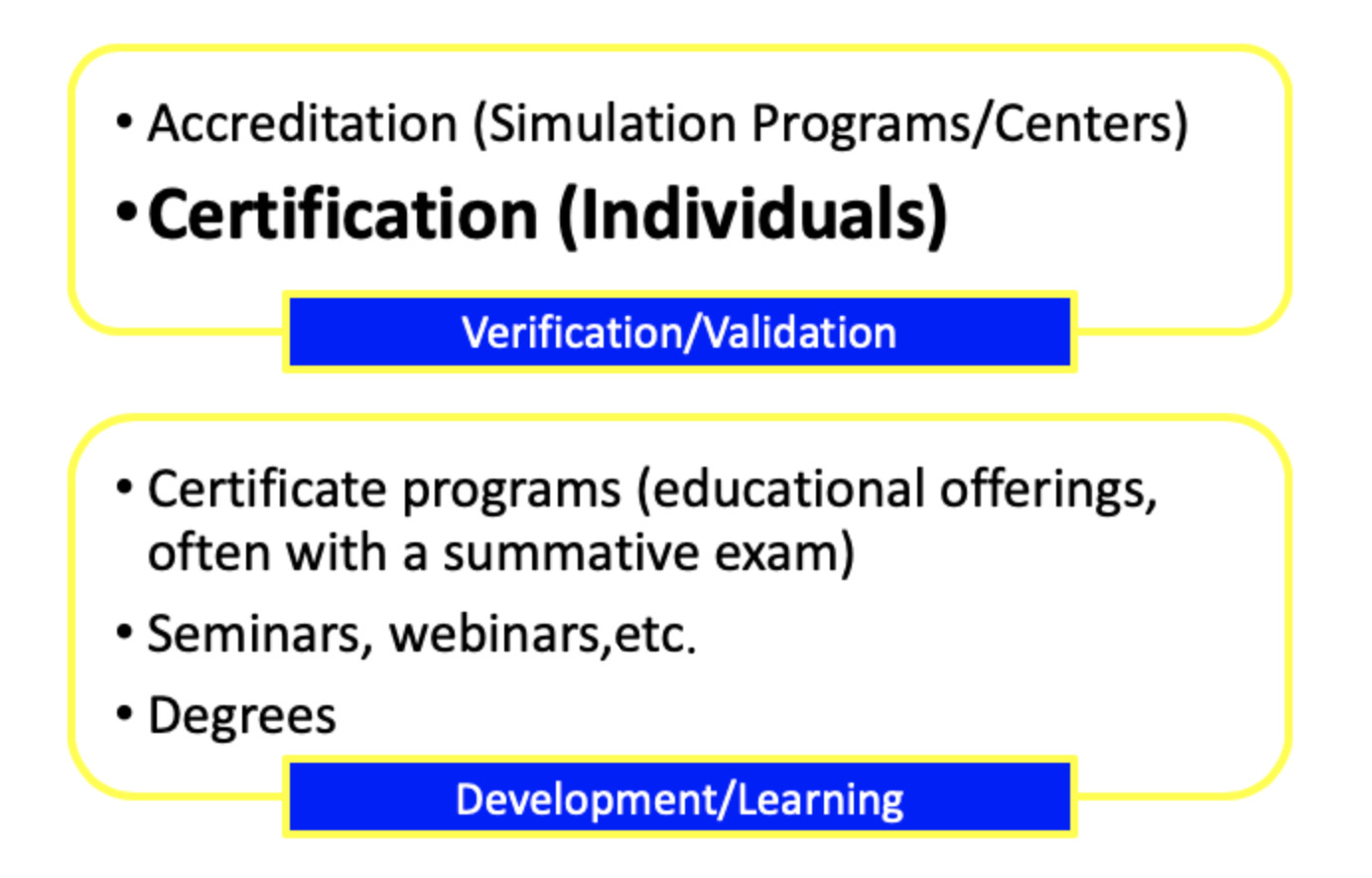
Description of Certification
Credentialing is an umbrella term that includes concepts such as professional certification, certificate programs, accreditation, licensure, and regulation. There is often confusion about what certification is, and the term is often used in ways that add to the confusion and instead should be another credentialing concept/term. The SSH certifications follow this definition:
A certification program is designed to test the knowledge, skills, and abilities required to perform a particular job, and, upon successfully passing a certification exam, to represent a declaration of a particular individual’s professional competence.
Certifications require many different steps to design and deliver that are psychometrically supported and grounded in an extensive practice analysis. Certifications are for individuals, and not for organizations. The following diagram displays where certification fits into the credentialing world:

Overview of Development
The development of the SSH certifications began in 2008 when the Board of Directors authorized the investigation of the need and concepts that would support them. The development of the certifications has been driven by the following key concepts:
- Certification is a voluntary process.
- Certification will be seen as a service to our members and our communities of interest.
- Certification will confirm the knowledge, skills, and attitudes essential to instructors in the field of simulation.
- Certification, in order to maximize efficiency and impact, should be a cooperative effort between simulation and professional organizations.
- Certification will be time-limited and renewable
CHSE® first launched in 2012, followed by CHSOS® in 2014. SSH would like to thank the healthcare simulation community for supporting these certifications that continue to grow around the world.
Selection of Subject Matter Experts (SMEs)
Given the broad nature of where and how healthcare simulation takes place, it is important for the certifications to have the input of individuals who possess extensive knowledge and experience in healthcare simulation from many perspectives. SSH is dedicated to ensuring that representation in the design of the certifications at all stages includes the voices of:
- simulation modality
- setting (locations where simulation takes place)
- geographic location
- learner population
- function (e.g. teaching, assessment)
- profession
Through capturing the many voices that are part of the healthcare simulation community, the resulting certifications serve to measure competency. SSH would like to thank the many SMEs who have helped develop the certifications over the years.
Practice Analysis
A Practice Analysis (PA, also called a Job Analysis) is the rigorous and systematic study of a profession to describe the job responsibilities of those employed in the profession. This information is then used to identify the knowledge and skills required to effectively carry out those responsibilities. The PA is essential to creating a certification and any product that is created without a practice analysis should not be held out as a certification.
The most recent PA for both CHSE® and CHSOS® was performed internationally in 2017-2018 with SMEs from around the globe at the meetings in Tampa, Hong Kong, and Amsterdam. The resulting examination blueprints are indicative of the worldwide practice of simulation that is consistent around the globe at the two-year competency level.
Item Writing Description
The items that are written for the CHSE® and CHSOS® examinations undergo a multi-step process. From the initial idea for a question, the question is then reviewed by multiple SMEs at in-person and virtual meetings, focused first on the individual items, and then on the creation of the exam forms. SSH’s psychometric partners, Schroeder Measurement Technologies, Inc. (SMT), oversees the entire process of creation, review, and statistical analysis of every item and the forms, ensuring that the exams created meet the desired intent—to measure the knowledge, skills, and abilities of individuals at the two-year competency level.
Standard Setting
There are often questions about setting of the cut scores for the examinations (also called the standard). SSH works with SMT to analyze the item and form performance through a number of perspectives. This includes the actual answers from those who have taken the exams, the input and review of the SMEs, and the psychometric analysis. This leads to the setting of the cut score for each form.
Equating
Since multiple forms (exams) are used with each certification, it is necessary to equate the scores of each exam. The purpose is to ensure that no matter which form is used for a candidate, there is a fair and equal chance of passing. SSH works with SMT to analyze the data from the exam forms, comparing the shared and unique content, and working to assign cut scores that are fair and equivalent for each form.
Should you have any questions about any of these items, please contact us by email.